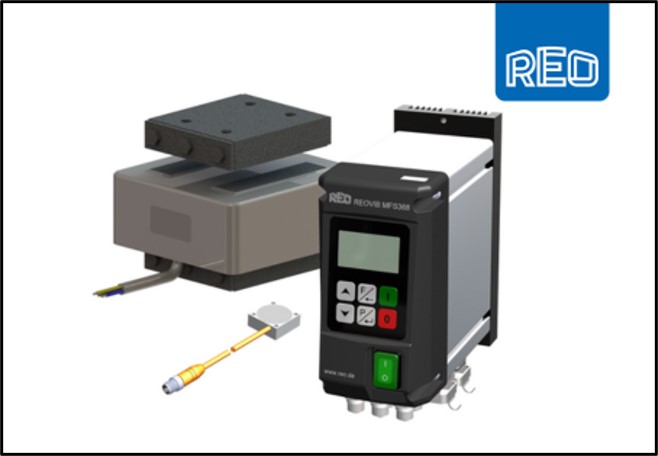Types of Conveyors used In Food Manufacturing
Downloads
| REO2025-10-Motor-Drive-vs-Electromagnetic-Conveyors-2.docx ( DOCX 241KB) |
| REO-Feeder-Products-4-scaled.jpg ( JPG 298KB) |
| REOVIB-MFS-368-IP54-3-scaled.jpg ( JPG 158KB) |
Increasingly, the food industry relies on efficient and precise material handling solutions to maintain productivity, quality, and food safety. Two primary types of conveyors dominate this sector: motor-driven conveyors and electromagnetic conveyors. While both are essential in food processing and packaging, their operational efficiency, energy consumption, and suitability for specific applications differ significantly. This paper explores the distinctions between these conveyor technologies, focusing on the latest advancements in energy-efficient control solutions for electromagnetic feeders.
Motor-Driven Conveyors
Motor-driven conveyors utilise electric motors to move food products along belts, rollers, or modular plastic surfaces. They are commonly found in high-volume food production environments requiring continuous transport.
Advantages:
- High Capacity: Suitable for bulk transportation of food products over long distances.
- Versatile: Can be used for various applications, including primary processing, packaging, and end-of-line logistics.
- Automated Integration: Easily integrated with robotic pick-and-place systems and other automated solutions.
Limitations:
- Higher Energy Consumption: Continuous motor operation and friction in the drive system result in increased power usage.
- Maintenance Requirements: Moving parts like belts, gearboxes and rollers require frequent servicing, increasing process downtime.
- Potential Contamination Risks: Crevices in belt systems may trap food particles, requiring strict sanitation procedures.
Electromagnetic Conveyors with Energy-Efficient Controllers
Electromagnetic conveyors, also known as vibratory feeders or conveyors, use electromagnetic drives to create controlled oscillations that move food products forward. They are widely used in the food industry for applications requiring precise product handling, such as seasoning, inspection, and sorting.
The latest range of energy-efficient controllers for electromagnetic feeders has significantly improved power consumption. For instance, modern controllers, such as the REOVIB MFS368 series, are up to 30% more efficient than previous iterations. These advancements allow precise control over vibration intensity and frequency, ensuring optimal energy use, consistent product flow, and reduced operational costs.
Advantages:
- Energy Efficiency: Operate intermittently, reducing overall power consumption. Advanced controllers optimise energy usage using Active Front End (AFE) technology.
- Gentle Product Handling: Ideal for fragile food items such as chips, nuts, and confectionery, with customisable vibration settings.
- Hygienic Design: Typically constructed from stainless steel with smooth surfaces, making them easier to clean and maintain.
- Improved Process Control: Modern controllers allow accurate adjustments, ensuring consistent feeding rates and optimised throughput.
Limitations:
- Limited Distance Capability: Best suited for short-to-medium distances rather than long transport runs.
- Lower load capacity: Not ideal for handling heavy food products in bulk.
- Vibration Considerations: Can cause dispersion of lightweight products if not adequately controlled, though advanced controllers help mitigate this by allowing precise adjustments and regulated throughput.
Industry Applications
- Motor-driven conveyors are commonly used in large-scale food production environments, such as bakeries, frozen food processing, and meat packaging lines where high throughput is required.
- Electromagnetic conveyors with energy-efficient controllers are ideal for applications that require gentle handling, precise control, and reduced power consumption, such as seasoning potato crisps, metering nuts into packaging, and inspecting confectionery products.
Conclusion
Choosing between motor-driven and electromagnetic conveyors depends on a food processing operation’s specific requirement. While motor-driven conveyors are best suited for high-capacity transport over long distances, electromagnetic conveyors offer superior energy efficiency, gentle handling, and enhanced hygiene for applications requiring precision.
The latest generation of energy-efficient controllers has further improved the viability of electromagnetic conveyors, making them a compelling choice for food manufacturers looking to reduce energy costs, improve consistency, and ensure precise material handling. Understanding these differences allows food processors to enhance their production lines while maintaining sustainability and cost-effectiveness.
To find out more about our MFS368 frequency converters, please visit https://www.reo.co.uk/products/frequency-converter-reovib-mfs-368/












